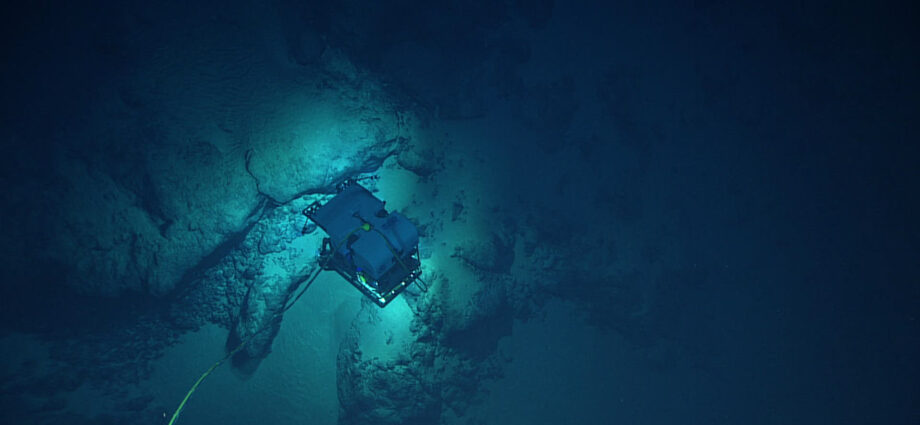
By Saman Ilankoon, Monash University Malaysia and Nimila Dushyantha, Uwa Wellassa University of Sri Lanka
July 5, 2023
On the ocean floor, robots will gather the rocks and suction pipes and hydraulic lifts will transport these to a surface vessel.
Renewable energy targets and the infrastructure needed to achieve them have created a high demand for certain metals and minerals, including critical metals.
Since the bottom of the world’s seas and oceans possesses significant amounts of critical metals, including manganese, cobalt, copper, zinc, gold, platinum and rare earth elements, deep-sea mining has emerged as a controversial yet promising method for diversifying critical metal supply chains.
Complex geological processes such as plate tectonics, volcanic activity at the ocean floor and hydrothermal vents have resulted in deep sea resources rich in critical metals and minerals over millions of years.
The European Commission and the US Geological Survey each have lists of critical minerals/materials needed for renewable energy technologies.
Building a three-megawatt wind turbine consumes 4.7 tonnes of copper, two tonnes of rare earth elements, three tonnes of aluminium, and a considerable amount of zinc and molybdenum.
Battery chemistries of electric vehicles (EVs) are rapidly evolving and lithium, manganese, nickel and cobalt are key critical metals to manufacture EV batteries. For now, current land-based mining and mineral processing activities supply the required critical metals but demand is increasing by the day.
The primary mineral deposits targeted in deep-sea mining are manganese nodules, seafloor massive sulphides and cobalt-rich crusts.
Manganese nodules or polymetallic nodules are mineral accumulations found on the seabed in sizes from one to 10cm.
These contain critical metals such as manganese, nickel, cobalt, copper and rare earth elements in high concentrations. The sulphide deposits have high base metal and sulphide contents plus gold and silver.
The cobalt-rich crusts are also termed polymetallic crusts or ferromanganese crusts and these are found on the slopes and surfaces of underwater hills and mountains and other rocky seabed structures at depths of 400 to 4,000 metres.
These crusts primarily comprise cobalt, manganese, nickel, titanium, rare earth elements, platinum, tellurium, vanadium and zirconium.
The International Seabed Authority which governs deep-sea mining, estimates cobalt content in crusts at one billion tonnes.
Deep-sea mining has yet to begin but it is challenging compared to terrestrial mining.
Since polymetallic nodules sit on a soft-sediment layer, large remotely operated vehicles with suction mechanisms can harvest the nodules from the ocean floor.
The nodules will be transported to the surface through a riser system to a ship. Once the nodules are separated on the ship, water and sediments will be pumped back into the ocean.
The challenging job is to remove the crusts containing only the targeted critical metals.
For cobalt-rich crusts attached to rocks, remote-controlled vehicles with cutting and suction devices are used. These employ real-time video feeds and precise control systems to ensure accurate mineral collection.
In 2021, the malfunction of a mining robot in the Pacific Ocean highlighted the challenges of deep sea mining.
Another method is to deploy dredging tools attached to surface vessels or remote-controlled vehicles to cut and extract the crusts. This requires a hydraulic pipe lift system to transport the extracted minerals to the surface.
Despite the great potential of deep sea mining in diversifying critical metal supply chains, the exploitation of deep sea resources poses significant risks to ocean ecosystems.
These are unique and fragile, and commercial mining activities’ short- and long-term impacts on ocean ecosystems have not yet been fully assessed.
Another risk is the potential release of methane, which is responsible for 30 percent of global warming.
Methane hydrates (white, ice-like solids that consist of methane and water) in the ocean hold around 1,000-5,000 gigatonnes of methane.
The release of this methane and the oxidation of methane to carbon dioxide due to warmer sea floor temperatures are significant climate change-related concerns in deep-sea mining.
The effects on marine ecosystems due to oxygen depletion and acidification of the oceans also need to be understood before deep-sea mining is allowed.
Several multinational companies including Google, BMW, AB Volvo Group and Samsung signed a moratorium on deep-sea mining in 2021, initiated by the World Wildlife Fund.
These companies said they would not use critical metals mined from the seabed in their supply chains, including for EVs and smartphones.
This development demonstrates the required balance between critical metals through deep-sea mining and conserving ocean ecosystems.
Dr Saman Ilankoon is senior lecturer in the Department of Chemical Engineering at the School of Engineering, Monash University Malaysia and fellow of the Institute of Materials, Minerals and Mining (IOM3), London.
Eng Nimila Dushyantha is lecturer at the Department of Applied Earth Sciences at Uwa Wellassa University, Sri Lanka. They declare no conflict of interest.
Subscribe to our newsletter.
Originally published under Creative Commons by 360info™.
Editors Note: mining technology

